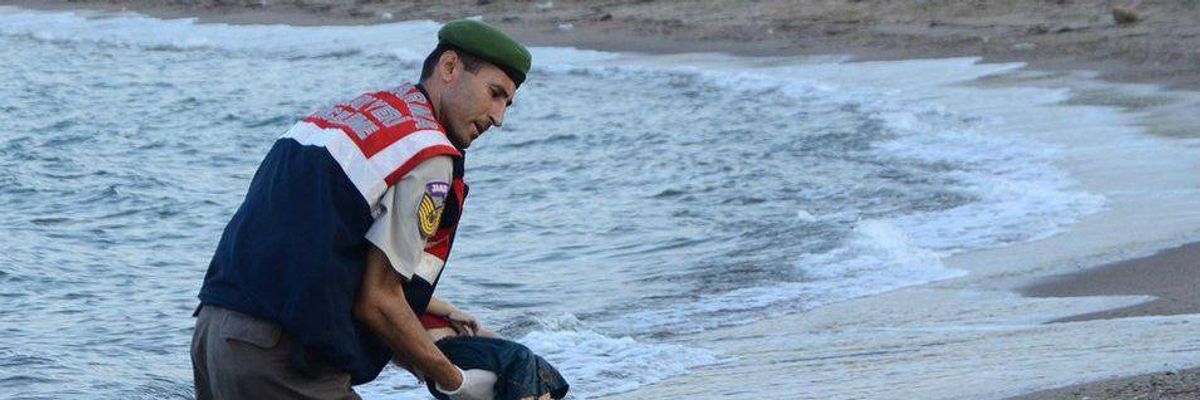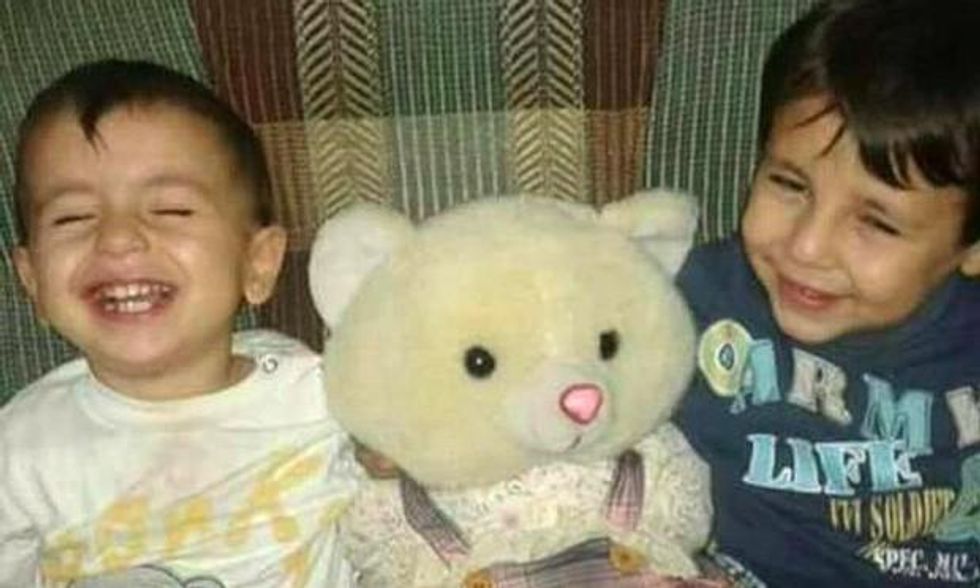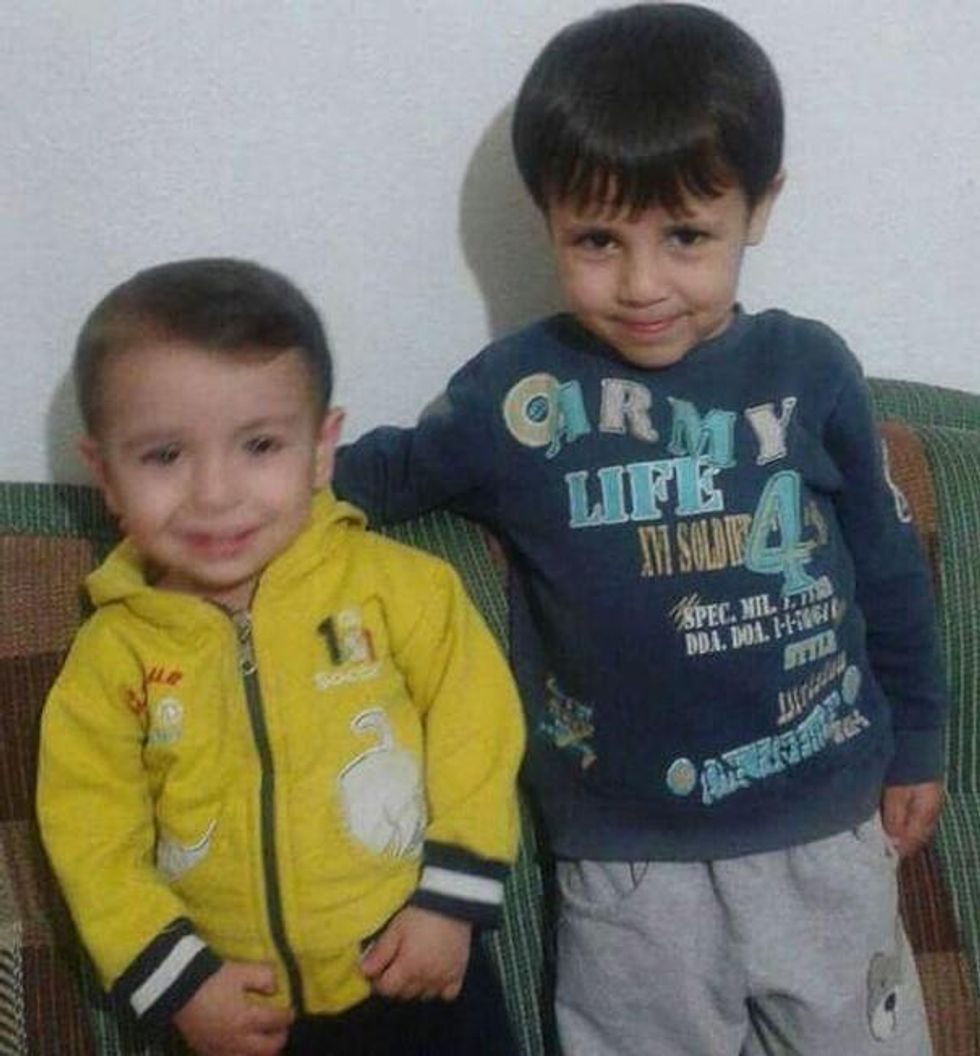

SUBSCRIBE TO OUR FREE NEWSLETTER
Daily news & progressive opinion—funded by the people, not the corporations—delivered straight to your inbox.
5
#000000
#FFFFFF
To donate by check, phone, or other method, see our More Ways to Give page.


Daily news & progressive opinion—funded by the people, not the corporations—delivered straight to your inbox.

A paramilitary police officer carries the lifeless body of three-year-old Aylan Kurdi after he drowned when the boat he and his family members were in capsized near the Turkish resort of Bodrum early Wednesday, Sept. 2, 2015. (Photo: Nilufer Demir/DHA)
As new details emerge about the young Syrian boy, now identified as three-year-old Aylan Kurdi--who drowned along with his mother, Rehan, and older brother, Galip, while the family attempted to cross the sea from Turkey to Greece on Wednesday--the global impact of the pictures has perhaps fulfilled the "sorrowful" hopes of the photographer who took the images in order to "make heard his outcry."
It has now been reported that the father, Abdullah Kurdi, was the only member of the family of four to survive when the boat they and other refugees were traveling in capsized off the Turkish coast. In all, according to Turkey's state-run Anadolu Agency, 12 people drowned when two boats attempting to reach the island of Kos capsized. Eight of the 12 were children. The news agency subsequently reported that several individuals had been arrested on smuggling charges related to the incident.
Other new information includes how the Kurdi family--which had fled their war-torn hometown of Kobani to reach safety--had been sponsored by a relative for asylum in Canada, but that the application had been rejected.
"I heard the news at five o'clock in this morning," Teema Kurdi, Abdullah's sister, told the National Post on Wednesday. Teema described how the telephone call came from Ghuson Kurdi, the wife of another brother, Mohammad. "She had got a call from Abdullah, and all he said was, my wife and two boys are dead."
According to the Post:
Teema, a Vancouver hairdresser who emigrated to Canada more than 20 years ago, said Abdullah and Rehan Kurdi and their two boys were the subject of a "G5" privately sponsored refugee application that was rejected by Citizenship and Immigration in June, owing to the complexities involved in refugee applications from Turkey.
The family had two strikes against them - like thousands of other Syrian Kurdish refugees in Turkey, the UN would not register them as refugees, and the Turkish government would not grant them exit visas.
"I was trying to sponsor them, and I have my friends and my neighbours who helped me with the bank deposits, but we couldn't get them out, and that is why they went in the boat. I was even paying rent for them in Turkey, but it is horrible the way they treat Syrians there," Teema said.
Just over twenty-four hours after his tragic and untimely death, the emotional power of the images of Aylan's lifeless body have become undeniable.
As the Wall Street Journalnotes, broadcast shows across Europe on Thursday "were already comparing the image's power to Nick Ut's Pulitzer Prize-winning 1972 photograph of a nine-year-old Vietnamese girl running naked, suffering agonizing burns from a napalm attack."
Nilufer Demir, the photographer from Turkey's Dogan News Agency who captured the haunting photographs, described the scene on the beach by saying she was "petrified" by the moment but took the pictures to fulfill her role as a journalist and make an attempt to give the young boy some kind of voice.
"Three-year-old Aylan Kurdi was lying lifeless face down in the surf, in his red t-shirt and dark blue shorts fold to his waist," she said in an interview with Dogan. "The only thing I could do was to make heard his outcry. At that moment, I believed I would be able to achieve this by triggering the shutter of my camera and took his picture."
And what did she feel as she witnessed this? "Pain and sorrow," she responded to the question. "I have pictured, witnessed many migrant incidents since 2003 in this region, their deaths, their drama. I hope from today, this will change."
Meanwhile, of course, the photos sparked conversations about the ethics of publishing such images prominently in news stories or sharing them unadulterated on social media platforms like Twitter and Facebook. For his part, Peter Bouckaert, director of emergencies for Human Rights Watch, described in a blog post why he contemplated long and hard before making his decision.
On the personal side, he explained of the photographs, "What struck me the most were his little sneakers, certainly lovingly put on by his parents that morning as they dressed him for their dangerous journey. One of my favorite moments of the morning is dressing my kids and helping them put on their shoes. They always seem to manage to put something on backwards, to our mutual amusement. Staring at the image, I couldn't help imagine that it was one of my own sons lying there drowned on the beach."
In the end, and despite reservations, he explained why he did share the photo:
Some say the picture is too offensive to share online or print in our newspapers. But what I find offensive is that drowned children are washing up on our shorelines, when more could have been done to prevent their deaths.
It was not an easy decision to share a brutal image of a drowned child. But I care about these children as much as my own. Maybe if Europe's leaders did too, they would try to stem this ghastly spectacle.
Social media continued to be the biggest driver behind the sharing and discussion of Demir's photographs of Aylan, even as joyful pictures of the young boy and his older brother emerged and people urged the world to see them as they "should be remembered":


Trump and Musk are on an unconstitutional rampage, aiming for virtually every corner of the federal government. These two right-wing billionaires are targeting nurses, scientists, teachers, daycare providers, judges, veterans, air traffic controllers, and nuclear safety inspectors. No one is safe. The food stamps program, Social Security, Medicare, and Medicaid are next. It’s an unprecedented disaster and a five-alarm fire, but there will be a reckoning. The people did not vote for this. The American people do not want this dystopian hellscape that hides behind claims of “efficiency.” Still, in reality, it is all a giveaway to corporate interests and the libertarian dreams of far-right oligarchs like Musk. Common Dreams is playing a vital role by reporting day and night on this orgy of corruption and greed, as well as what everyday people can do to organize and fight back. As a people-powered nonprofit news outlet, we cover issues the corporate media never will, but we can only continue with our readers’ support. |
As new details emerge about the young Syrian boy, now identified as three-year-old Aylan Kurdi--who drowned along with his mother, Rehan, and older brother, Galip, while the family attempted to cross the sea from Turkey to Greece on Wednesday--the global impact of the pictures has perhaps fulfilled the "sorrowful" hopes of the photographer who took the images in order to "make heard his outcry."
It has now been reported that the father, Abdullah Kurdi, was the only member of the family of four to survive when the boat they and other refugees were traveling in capsized off the Turkish coast. In all, according to Turkey's state-run Anadolu Agency, 12 people drowned when two boats attempting to reach the island of Kos capsized. Eight of the 12 were children. The news agency subsequently reported that several individuals had been arrested on smuggling charges related to the incident.
Other new information includes how the Kurdi family--which had fled their war-torn hometown of Kobani to reach safety--had been sponsored by a relative for asylum in Canada, but that the application had been rejected.
"I heard the news at five o'clock in this morning," Teema Kurdi, Abdullah's sister, told the National Post on Wednesday. Teema described how the telephone call came from Ghuson Kurdi, the wife of another brother, Mohammad. "She had got a call from Abdullah, and all he said was, my wife and two boys are dead."
According to the Post:
Teema, a Vancouver hairdresser who emigrated to Canada more than 20 years ago, said Abdullah and Rehan Kurdi and their two boys were the subject of a "G5" privately sponsored refugee application that was rejected by Citizenship and Immigration in June, owing to the complexities involved in refugee applications from Turkey.
The family had two strikes against them - like thousands of other Syrian Kurdish refugees in Turkey, the UN would not register them as refugees, and the Turkish government would not grant them exit visas.
"I was trying to sponsor them, and I have my friends and my neighbours who helped me with the bank deposits, but we couldn't get them out, and that is why they went in the boat. I was even paying rent for them in Turkey, but it is horrible the way they treat Syrians there," Teema said.
Just over twenty-four hours after his tragic and untimely death, the emotional power of the images of Aylan's lifeless body have become undeniable.
As the Wall Street Journalnotes, broadcast shows across Europe on Thursday "were already comparing the image's power to Nick Ut's Pulitzer Prize-winning 1972 photograph of a nine-year-old Vietnamese girl running naked, suffering agonizing burns from a napalm attack."
Nilufer Demir, the photographer from Turkey's Dogan News Agency who captured the haunting photographs, described the scene on the beach by saying she was "petrified" by the moment but took the pictures to fulfill her role as a journalist and make an attempt to give the young boy some kind of voice.
"Three-year-old Aylan Kurdi was lying lifeless face down in the surf, in his red t-shirt and dark blue shorts fold to his waist," she said in an interview with Dogan. "The only thing I could do was to make heard his outcry. At that moment, I believed I would be able to achieve this by triggering the shutter of my camera and took his picture."
And what did she feel as she witnessed this? "Pain and sorrow," she responded to the question. "I have pictured, witnessed many migrant incidents since 2003 in this region, their deaths, their drama. I hope from today, this will change."
Meanwhile, of course, the photos sparked conversations about the ethics of publishing such images prominently in news stories or sharing them unadulterated on social media platforms like Twitter and Facebook. For his part, Peter Bouckaert, director of emergencies for Human Rights Watch, described in a blog post why he contemplated long and hard before making his decision.
On the personal side, he explained of the photographs, "What struck me the most were his little sneakers, certainly lovingly put on by his parents that morning as they dressed him for their dangerous journey. One of my favorite moments of the morning is dressing my kids and helping them put on their shoes. They always seem to manage to put something on backwards, to our mutual amusement. Staring at the image, I couldn't help imagine that it was one of my own sons lying there drowned on the beach."
In the end, and despite reservations, he explained why he did share the photo:
Some say the picture is too offensive to share online or print in our newspapers. But what I find offensive is that drowned children are washing up on our shorelines, when more could have been done to prevent their deaths.
It was not an easy decision to share a brutal image of a drowned child. But I care about these children as much as my own. Maybe if Europe's leaders did too, they would try to stem this ghastly spectacle.
Social media continued to be the biggest driver behind the sharing and discussion of Demir's photographs of Aylan, even as joyful pictures of the young boy and his older brother emerged and people urged the world to see them as they "should be remembered":


As new details emerge about the young Syrian boy, now identified as three-year-old Aylan Kurdi--who drowned along with his mother, Rehan, and older brother, Galip, while the family attempted to cross the sea from Turkey to Greece on Wednesday--the global impact of the pictures has perhaps fulfilled the "sorrowful" hopes of the photographer who took the images in order to "make heard his outcry."
It has now been reported that the father, Abdullah Kurdi, was the only member of the family of four to survive when the boat they and other refugees were traveling in capsized off the Turkish coast. In all, according to Turkey's state-run Anadolu Agency, 12 people drowned when two boats attempting to reach the island of Kos capsized. Eight of the 12 were children. The news agency subsequently reported that several individuals had been arrested on smuggling charges related to the incident.
Other new information includes how the Kurdi family--which had fled their war-torn hometown of Kobani to reach safety--had been sponsored by a relative for asylum in Canada, but that the application had been rejected.
"I heard the news at five o'clock in this morning," Teema Kurdi, Abdullah's sister, told the National Post on Wednesday. Teema described how the telephone call came from Ghuson Kurdi, the wife of another brother, Mohammad. "She had got a call from Abdullah, and all he said was, my wife and two boys are dead."
According to the Post:
Teema, a Vancouver hairdresser who emigrated to Canada more than 20 years ago, said Abdullah and Rehan Kurdi and their two boys were the subject of a "G5" privately sponsored refugee application that was rejected by Citizenship and Immigration in June, owing to the complexities involved in refugee applications from Turkey.
The family had two strikes against them - like thousands of other Syrian Kurdish refugees in Turkey, the UN would not register them as refugees, and the Turkish government would not grant them exit visas.
"I was trying to sponsor them, and I have my friends and my neighbours who helped me with the bank deposits, but we couldn't get them out, and that is why they went in the boat. I was even paying rent for them in Turkey, but it is horrible the way they treat Syrians there," Teema said.
Just over twenty-four hours after his tragic and untimely death, the emotional power of the images of Aylan's lifeless body have become undeniable.
As the Wall Street Journalnotes, broadcast shows across Europe on Thursday "were already comparing the image's power to Nick Ut's Pulitzer Prize-winning 1972 photograph of a nine-year-old Vietnamese girl running naked, suffering agonizing burns from a napalm attack."
Nilufer Demir, the photographer from Turkey's Dogan News Agency who captured the haunting photographs, described the scene on the beach by saying she was "petrified" by the moment but took the pictures to fulfill her role as a journalist and make an attempt to give the young boy some kind of voice.
"Three-year-old Aylan Kurdi was lying lifeless face down in the surf, in his red t-shirt and dark blue shorts fold to his waist," she said in an interview with Dogan. "The only thing I could do was to make heard his outcry. At that moment, I believed I would be able to achieve this by triggering the shutter of my camera and took his picture."
And what did she feel as she witnessed this? "Pain and sorrow," she responded to the question. "I have pictured, witnessed many migrant incidents since 2003 in this region, their deaths, their drama. I hope from today, this will change."
Meanwhile, of course, the photos sparked conversations about the ethics of publishing such images prominently in news stories or sharing them unadulterated on social media platforms like Twitter and Facebook. For his part, Peter Bouckaert, director of emergencies for Human Rights Watch, described in a blog post why he contemplated long and hard before making his decision.
On the personal side, he explained of the photographs, "What struck me the most were his little sneakers, certainly lovingly put on by his parents that morning as they dressed him for their dangerous journey. One of my favorite moments of the morning is dressing my kids and helping them put on their shoes. They always seem to manage to put something on backwards, to our mutual amusement. Staring at the image, I couldn't help imagine that it was one of my own sons lying there drowned on the beach."
In the end, and despite reservations, he explained why he did share the photo:
Some say the picture is too offensive to share online or print in our newspapers. But what I find offensive is that drowned children are washing up on our shorelines, when more could have been done to prevent their deaths.
It was not an easy decision to share a brutal image of a drowned child. But I care about these children as much as my own. Maybe if Europe's leaders did too, they would try to stem this ghastly spectacle.
Social media continued to be the biggest driver behind the sharing and discussion of Demir's photographs of Aylan, even as joyful pictures of the young boy and his older brother emerged and people urged the world to see them as they "should be remembered":

